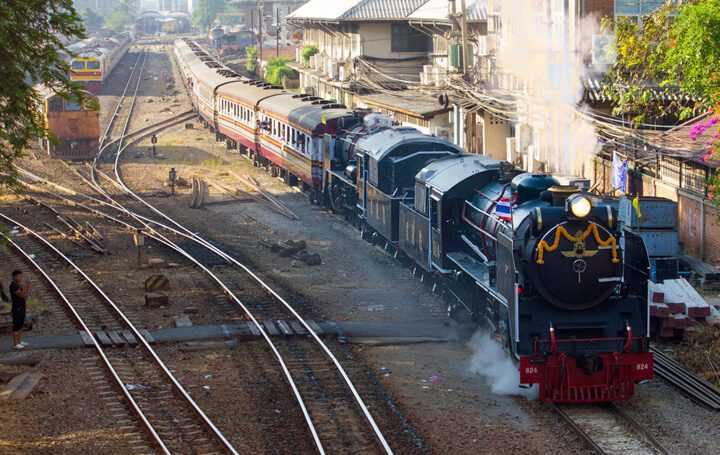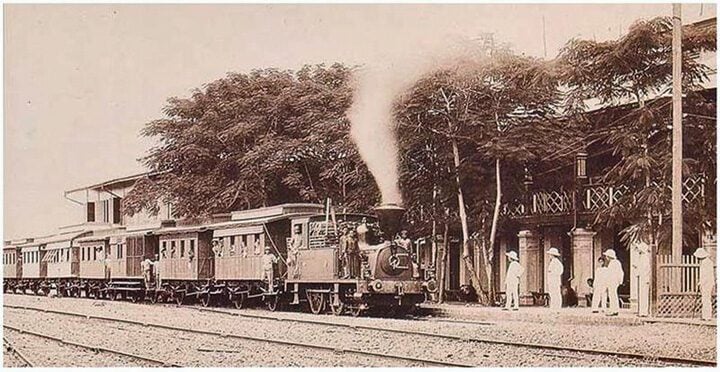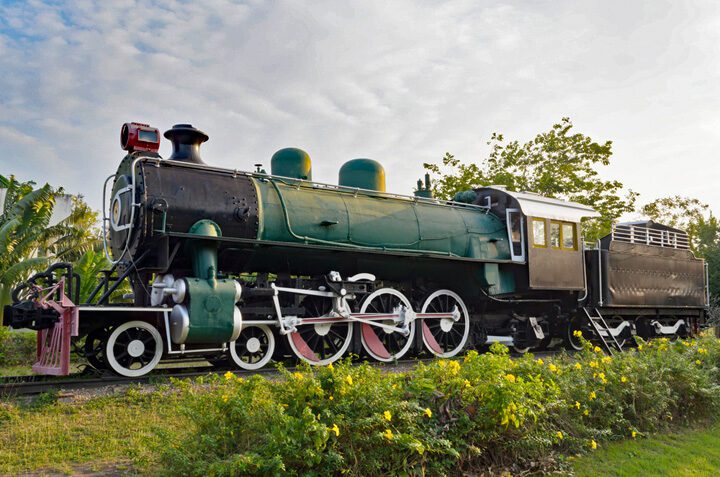History of Thai Railways
The transport of goods and persons Thailand took place over the rivers and canals or over land for centuries with animals such as oxen, buffaloes, horses, elephants with howdahs and bullock carts.
Domestic rail transport was unknown in Thailand until well into the 19th century. It was the Thai King Chulalongkorn (Rama V), who by his many journey well aware of technical and industrial developments in Asia and Europe, initiated the development of Thai railways. A railway network would not only improve domestic communications, which would benefit the people and the economy, but would also be a good means of protecting Thai territory against the colonial expansionism that was taking place in neighboring countries.
In October 1890, King Chulalongkorn approved the establishment of a Ministry of Railways, and in 1891, the first railway was started in what was then Siam, from Bangkok to Nakhon Ratchasima. The first train from Bangkok to Ayutthaya ran on March 26, 1894 and the railway network was steadily expanded.

Father's Day Steam Train Ride - KITTIKUN YOKSAP / Shutterstock.com
The Ministry of Railways was divided into two departments, the Northern and the Southern Railways. The Northern Railways was responsible for the railways west of the Chao Phaya River and the Southern Railways had the same function for the railways east of the river. Mostly Europeans worked in both departments, which in the long run was considered too expensive. Both departments merged in 1917 and became the Royal State Railways of Siam.
A technical problem arose in the further development of the railways. The former Northern Railways had a gauge of 1,4435 meters and the Southern Railways used the internationally customary 1,00 meter gauge. That was not good for the development of the railways as a whole and by Royal Decree the track width for the entire country was set at 1,00 metres, the same as the track width in Malaysia, Burma and Cambodia. The adjustment of all 1,4435 m railways took ten years and was completed in 1930.
Until 1910, the end of the Rama V period, 932 kilometers of railways had been built. The expansion continued under the following kings, so that in 1946 a railway network of 2518 kilometers was completed. That could have been much longer if the Second World War had not broken out. The railways in Thailand then suffered heavily from the many bombings. Many buildings, bridges, train equipment, rails were destroyed and everything had to be repaired and rebuilt after the war.
A new turning point was the legal regulation of 1952, where then the official current name State Railway of Thailand arises from. The rail network is currently over 4100 km to all parts of Thailand. It is also the largest state employer with over 26.000 employees.




Standard gauge is 144,5 cm and is the most used worldwide. 1 meter of track is so-called narrow gauge.
In Switzerland this is often found on very winding stretches. (including the network of the Rhaetian Railway)
I have read that at the time the choice for 1 meter of track in Thailand was made for economic reasons. Narrow gauge is much cheaper to build than standard gauge.
Narrow gauge (1 meter) is unsuitable for high speed lines.
Hansy,
The railway standard width is 143,5 cm.
Furthermore, there are wider track widths in Europe (Spain, Finland, Russia, Ireland).
Also a few lines of 100 cm, here and there.
The first railway in Thailand was built by a German company in 143,5 cm.
I believe during the first world war, the construction was taken over by an English company, which used the 100 cm width, as in India, Burma, Malaysia, Indonesia.
The result is a limited maximum speed, lower axle load, and more of that restrictive stuff.
Let me come back to Mario for a moment.
The actual construction of the HSL Asd-Bd-Belgium really took only 3 years and 9 months.
A lot of time has been lost due to the land purchase, the hassle about the train influence (ERTS) and the usual Dutch sideliness and environmental freaks.
I bet the Thai don't run into such problems.
And the Chinese are certainly capable of building an HSL up to 3 km/h with a distance of 4-250 km in 400-600 years.
The biggest problem would be Bangkok, and if Suvarnibhumi is chosen as a station in Bangkok, there is suddenly a smaller problem
Incidentally, depending on the subsoil, it may or may not be necessary to drive a pile when using concrete gutters.
The actual ability of the subsoil to drain determines the type and size of the layers of crushed stone, and this in turn determines the type of sleepers, the strength of the rail.
Incidentally, given the new technology for diesel locomotives, with which speeds can be reached at HSL level, it is quite possible that the Chinese will decide to build a diesel network.
This makes a considerable difference in costs (no overhead line, substations, etc.) and lead time of construction.
By the way, the standard gauge of 143,5 cm is also used on the HSL, the HSL in Spain is also 143,5 cm, while the rest of Spain has a wider gauge.
I know something about it, I'm a rail enthusiast myself.
In India, the main network is broad gauge (167,6 cm). This used to be a meter gauge. Already 24.000 km of the 30.000 km of track have been converted.
Indonesia has Cape Trail. This is 106,7 cm, and not so widely used worldwide.
I don't believe that diesels can drive an HSL. For HSL trains you need a power of about 5.000 kW in the front and rear units, to give a train the high speed and the pulling capacity on slopes (in DLD and FR about 5%).
In the USA, the land of diesels, 6-axle units are made with “only” 3.200 kW. (eg SD90MAC). These locomotives were also delivered with 4400 kW, but were taken out of production due to major problems.
well,
Return to Bangkok station.
A new central station “Bang-Sue” (behind the Chatuchak market) was chosen. During construction, it was decided to extend the platforms so that they are also suitable for the HSL. The Red-Line running from the central station “Bang-Sue” via Lak-Si and Don Muang to Rangsit is a high above-ground BTS, which has now been made 4 tracks. 2 tracks for the BTS and 2 tracks for the railways. The intercity, freight trains and the future HSL must run over this.
Beyond Rangsit there is room for a separate HSL line. The intermediate stations are built in such a way that the BTS runs on the outside and the rail trains on the inner two tracks, only past the Don Muang station, (seen from Bangkok) the tracks of the trains are led to the right side, they also have an overhead wire . The BTS has a guide rail.
After about 4 kilometers, past Den Muang station in the direction of Rangsit, the tracks go to arrow 0 (ground floor), which is of course very dangerous for a Thai. The Thai breaks with the greatest of ease, a hole in the fence to walk to the other side, preferably with a scooter or handcart and all. I also foresee the necessary deaths here in the near future.
I don't know if the "old" rails will be preserved until Don Muang, in any case no maintenance is done on level crossings anymore. Past Don Muang, the BTS will drive partly over the old railway track and the "old" rails will be broken up. The first 5 stations are already at an advanced stage. Only Don Muang (twice as long as the other 2) and Bang-Sue still have a lot of work to do.
\
According to the latest reports, the delivery is in 2020.
Greetings Gerrit from Lak-Si (Bangkok)
And if, for example, the right-hand rails and sleepers sag 3 cm on a narrow-gauge railway, you are in trouble! At broad gauge, the traveler feels a nod to the right. But with narrow gauge the wagon or even the whole train is right next to the rails!!
That happened a few times in the route to Chiangmai 2 years ago. Was even shut down and repaired.
You can already feel it coming: on the opening run the train flipped on its side again! I can't tell if it was the left or right shoulder.
Peer
In the years around 1876 there was a fact finding trip organized by The British Empire to establish a rail link from Maulmein in Myanmar via the Tak region in Thailand to Chiang Mai and Chiang Rai with the intention of north of Chiang Rai in Myanmar and then bend eastward to China's Yunnan.
If I may recommend a voluminous book about that: 'A Thousand Miles on an Elephant in the Shan States' by author Holt S Hallet. The book is in English but my translation can be found on the internet at a fellow blog.
He also mentioned the possibility of connecting to the not yet existing route in Thailand. The British wanted to limit the influence of the French (Laos and present-day Vietnam) by opening a trade line to China. The line itself has not been built and as far as I know there is still no connection to the Myanmar rail network.
If you want to read about the development of the Thai rail network to the south, you can look for the book by Henry Gittins entitled 'On Track'. The book is in English.
Gittins pioneered in the 1885s and became the chief executive of the Siamese Railways. It was he who connected Hua Hin and developed the line to the south. But he also worked on Canadian Railways.
The BBC has a nice series about Asian railways, including in Thailand: Great Asian Railway Journeys. In addition to beautiful images from various trains and routes, there is also a lot of attention for the local culture in the places that presenter Michael visits. Broadcast by the Belgian last year. More info: https://www.bbc.co.uk/programmes/m000dtbn